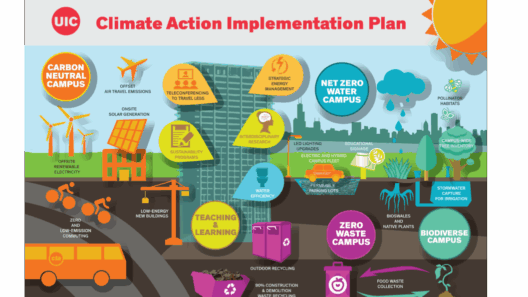In recent decades, the vexing question of whether it is possible to reverse climate change has taken center stage in global discourse. Many individuals feel overwhelmed by the overarching narrative of impending ecological catastrophe and the challenges it poses. The skepticism surrounding the concept of mitigation often leads to a fatalistic view: that it might already be too late to effect meaningful change. However, a shift in perspective is essential. Would it not be prudent to assess both the alarming realities of climate change as well as the efficacious strategies available to combat it? This article will explore the mechanisms of climate change, the strategies for reversal, and the timing of our interventions in this crucial battle for our planet’s future.
Climate change is driven primarily by the accumulation of greenhouse gases (GHGs) such as carbon dioxide (CO2) and methane (CH4) in the atmosphere. Activities of modern civilization—including fossil fuel consumption, deforestation, and industrial agriculture—contribute significantly to these emissions. The result is a warming planet leading to detrimental impacts such as unprecedented weather patterns, rising sea levels, and the degradation of biodiversity. As these impacts become increasingly ubiquitous, it is tempting to adopt a skeptical mindset, asserting that all efforts may be in vain. Yet, such a viewpoint neglects the available avenues for mitigation and adaptation, which are burgeoning at an astonishing rate.
One such promising avenue is the advancement of technology aimed at carbon capture and storage (CCS). This innovative technology seeks to encapsulate CO2 emissions from industrial sources and store them underground, preventing them from entering the atmosphere. It offers a dual benefit of reducing current emissions while simultaneously addressing the existing carbon backlog in the atmosphere. Particularly in industrial power generation, where emissions are notoriously high, CCS represents a significant lever for reversing climate change. According to current findings, employing CCS on a large scale could reduce GHG emissions substantially—potentially even by half—thereby providing a much-needed buffer.
Complementing technological initiatives, there are also divine synergies between nature and climate action referred to as “nature-based solutions.” These strategies leverage the power of ecosystems to sequester carbon. For instance, reforestation initiatives not only absorb CO2 but also restore biodiversity and enhance local ecosystems. The restoration of mangroves and wetlands serves a dual purpose: it sequesters substantial amounts of carbon while providing critical habitats that can shield coastal communities from storm surges and flooding. Ensuring the integrity of these natural methodologies presents a viable pathway to reestablish ecological balance.
However, to fully harness these technologies and natural solutions, a comprehensive recalibration of economic paradigms is pivotal. Governments, private enterprises, and individuals alike must advocate for and invest in sustainable practices. Economic instruments like carbon pricing can incentivize a shift toward lower emissions while fostering innovation in clean technologies. The urgency of transitioning to renewable energy sources—solar, wind, and hydro—cannot be underestimated. As efficiency improves and costs decline, clean energy becomes a more economically viable option. Such transformations pivot on investments that hold not only environmental value but also economic promise.
Education and advocacy also play an indispensable role in reversing climate change. The growing awareness of climate issues can mobilize public support for policy changes and spur collective action. Educational programs tailored to different demographics can foster an understanding of the interconnectivity of human actions and environmental consequences. Individuals empowered with knowledge are more likely to make informed decisions and act in ways that contribute positively to combatting climate change.
Yet, amidst burgeoning hope, one must confront the pressing question: is it too late? The prevailing scientific consensus posits that we have already witnessed significant changes in the planet’s climate system. However, the narrative must shift from despair to possibility. Some scholars argue that while the window for achieving major reductions in GHG emissions is rapidly closing, the option of carefully orchestrated intervention strategies isn’t off the table entirely. The assertion that it is “too late” can dissuade engagement; rather, it should invigorate collective resolve.
As individuals, communities, and nations grapple with these realities, fostering resilience becomes paramount. Human adaptability has been a hallmark of our species, enabling us to survive and thrive amidst challenges. Investments in disaster preparedness, community adaptation strategies, and robust infrastructure can bolster resilience against climate impacts while paving the way for actions that mitigate future challenges.
Another crucial aspect is global collaboration. Climate change knows no borders; thus, a concerted international approach is essential. Agreements such as the Paris Accord provide frameworks for nations to commit to emission reduction targets. These efforts must be bolstered by accountability measures and transparent progress tracking to ensure each nation upholds its commitments. Only through synergistic efforts can we hope to forge a sustainable future.
In conclusion, reversing climate change is not merely a utopian dream but a vibrant possibility contingent upon action and innovation. While challenges abound, so too do solutions. The convergence of technology, nature-based approaches, economic recalibrations, education, and cooperative frameworks equips society with the necessary tools to make a difference. The urgency with which we move toward these solutions will determine the legacy we leave for future generations. Hence, rather than yielding to a pessimistic outlook, we must embrace hope, recognizing that perhaps we are not too late but just in time to forge a sustainable path forward.




